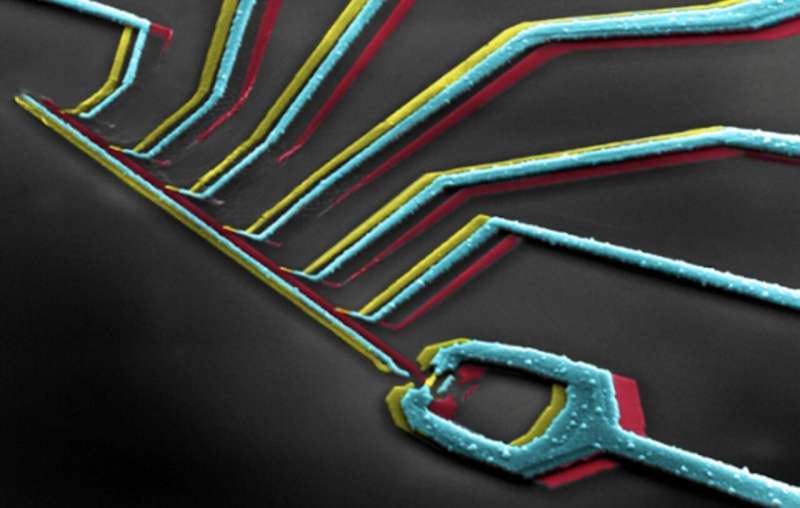A thermal superconducting quantum interference proximity transistor

Superconductors are materials that can achieve a state known as superconductivity, in which matter has no electrical resistance and does not allow the penetration of magnetic fields. At low temperatures, these materials are known to be highly effective thermal insulators and, due to the so-called proximity effect, they can also influence the density of states of nearby metallic or superconducting wires.
Researchers at Istituto Nanoscienze (CNR) and Scuola Normale Superiore in Italy have recently developed a transistor that takes advantage of this specific quality of superconductors. Their transistor, dubbed a thermal superconducting quantum interference proximity transistor (T-SQUIPT), was introduced in a paper published in Nature Physics.
“Our work lies in the frame of phase-coherent caloritronics that aims to envision and realize devices able to master the energy transfer in different nano-scale quantum technology architectures,” Francesco Giazotto, one of the researchers who carried out the study, told Phys.org.
The main idea behind T-SQUIPT, the transistor developed by Giazotto and his colleagues, is to tune the thermal properties of a metal or superconductor by controlling its spectral characteristics, through the so-called superconducting proximity effect. Essentially, the transistor exploits the macroscopic superconducting quantum phase to control the density of states in a metal in the proximity of the superconductor, thus modulating its thermal transport properties.
“T-SQUIPT was first theoretically proposed by some of the authors of our recent paper several years ago, although without a concrete realization yet,” Giazotto said. “Our implementation of the T-SQUIPT exploits a long superconducting nanowire as proximitized element thus allowing us to demonstrate the possibility to phase-tune the thermal transport properties of a superconductor and to realize the first thermal memory cell as well.”
Normal metals are known to be good conductors of both electricity and heat, as they are able to allow electrons contained in their crystals to transfer heat and charge. In contrast, while superconductors are good electrical conductors (i.e., showing zero resistance), they are poor thermal conductors, as the main “free carriers” in their crystals are Cooper pairs. Cooper pairs are charged pairs of electrons that cannot transfer heat, as they are dissipationless in nature.
“The core concept of T-SQUIPT is a nanoscopic island of aluminum (Al) that can be made superconducting- or normal metal-like with quantum interference induced by two superconducting leads defining a ring and placed in good metallic contact with the island,” Giazotto explained.
“For integer values of the flux quantum piercing the superconducting loop, superconductivity is reinforced and the island behaves as a good thermal insulator. For semi-integer values of the flux quantum, superconductivity is ideally suppressed, and the island behaves as a good thermal conductor.”
This unique design, first introduced by the researchers in a paper published in 2014, allows them to suppress or reinforce superconductivity in their transistor at will, simply by applying an external magnetic field. As a result, the thermal conductivity of the aluminum island in the transistor can be fully manipulated, making it a so-called thermal valve.
As part of their recent study, Giazotto and their colleagues demonstrated this ability of their transistor by sinking heat from a metallic electrode into it, which was also coupled to the aluminum island through a tunnel contact. Overall, their findings demonstrate the feasibility of phase-coherently manipulating the energy transport qualities of quantum devices.
“T-SQUIPT opens the way to the realization of structures where the control of the heat transport enables to envision and realize the thermal counterparts of electronic devices, such as thermal transistors, memories, logic gates and thermoelectric engines,” Giazotto said. “From a fundamental point of view, our method also demonstrates the possibility to investigate chargeless quantum modes in solid-state systems, such as Majorana bound states and parafermions, that could not be detected by conventional charge transport techniques.”
In the future, the T-SQUIPT transistor could pave the way towards the realization of a variety of new devices. The recent paper also enhances the current understanding of energy transfer at the nanoscale, thus potentially improving its management.
In the future, the recent work by Giazotto and his colleagues could inspire new studies investigating the quantum thermodynamic properties in superconducting nano-systems. In their next studies, the team at Istituto Nanoscienze (CNR) and Scuola Normale Superiore will try to enhance the performance of T-SQUIPT, by improving the design of the thermal valve and by using superconducting materials that allow its use at temperatures of a few Kelvin degrees.
“We also plan to study the time response of the memory cell in order to investigate its writing/erasing time and its ability to retain the encoded data over several days,” Giazotto added. “This would represent the next crucial step for a practical implementation of thermal computing and memory logic architectures.”
Quantum thermal transistor can control heat currents
Nadia Ligato et al, Thermal superconducting quantum interference proximity transistor, Nature Physics (2022). DOI: 10.1038/s41567-022-01578-z
E. Strambini et al, Proximity nanovalve with large phase-tunable thermal conductance, Applied Physics Letters (2014). DOI: 10.1063/1.4893759
© 2022 Science X Network
Citation:
A thermal superconducting quantum interference proximity transistor (2022, May 5)
retrieved 5 May 2022
from https://phys.org/news/2022-05-thermal-superconducting-quantum-proximity-transistor.html
This document is subject to copyright. Apart from any fair dealing for the purpose of private study or research, no
part may be reproduced without the written permission. The content is provided for information purposes only.
For all the latest Science News Click Here
For the latest news and updates, follow us on Google News.

